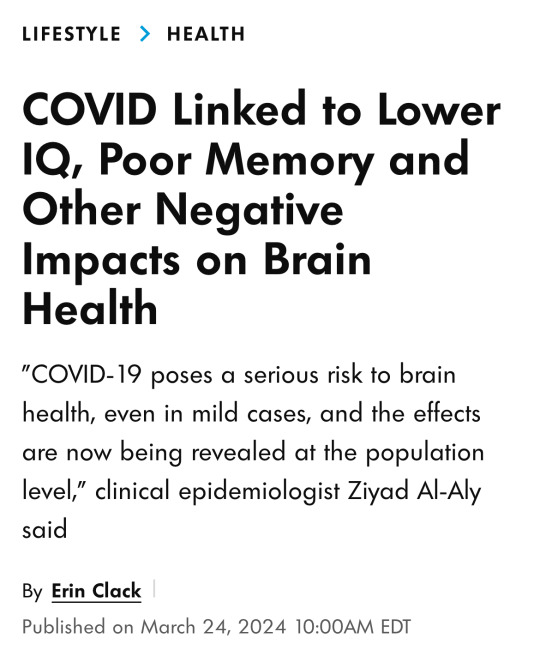#brain inflammation
Text



side-eyeing all the anti-vaccine, anti-masks, "get back to normal," "the kids will be fine" fucktwats hella hard right now. fuck everyone one of you.
#COVID#brain health#cognitive deficits#memory problems#brain inflammation#brain aging#brain volume#brain structure#COVID-19#SARS-CoV-2#long COVID#brain damage#dementia#autopsies#respiratory virus
84 notes
·
View notes
Text






most days all i can think about is religion; mostly christianity. i'm very fixated on it but because of my encephalitis i have a hard time thinking clearly and in order so i can't even understand what i believe in no matter how much i think about it or how much i read it. this is upsetting to me because all i want to do is learn more about my religion.
#religion#i can't think clearly#mention of religion#episcopal#episcopalian#christian#encephalitis#brain inflammation#hyper fixated#hyper fixation#catholiscism#southern gothic aesthetic#queer christian#i love jesus#saint mary#anglican#anglo catholic
26 notes
·
View notes
Link
Pandemics don’t go away because people get bored with them. And COVID-19 has shown an unusual ability to adapt to our defenses against it. It is certainly not “just the flu” as some slackers and anti-vaxxers foolishly claim.
Researchers have discovered that the Omicron BA.2 subvariant can produce brain inflammation.
New research on the Omicron subvariant of the coronavirus has suggested the pathogen could be changing how it attacks the human body - shifting from infecting respiratory systems to increasingly targeting the brain.
Researchers from Australia and France found BA.5 - the coronavirus subvariant driving what is now the world's biggest surge of infections in China - did much more severe damage to mouse brains and cultured human brain tissues than the previous BA.1 subvariant, leading to brain inflammation, weight loss and death.
The findings challenge the common belief that viruses usually evolve to become less pathogenic.
"Compared with BA. 1, we found that a BA.5 isolate displayed increased pathogenicity in K18-hACE2 mice with rapid weight loss, brain infection and encephalitis, and mortality. In addition, BA.5 productively infected human brain organoids significantly better than BA. 1," a manuscript of the research said.
The bivalent boosters from Pfizer and Moderna provide improved protection against BA.5.
New Covid boosters work better against infection than previous shots, CDC finds
The first real-world data on the new omicron vaccines find that they are better at preventing symptomatic Covid infections than the earlier doses, the Centers for Disease Control and Prevention said Tuesday.
The findings fortify messaging from public health officials that the new shots, from Pfizer-BioNTech and Moderna, should provide people with the best protection against Covid this winter, according to the CDC report.
Both Pfizer’s and Moderna’s new boosters target BA.4 and BA.5, along with the original coronavirus strain, in a single dose.
If you plan to attend a crowded New Year’s celebration, it’s a good idea to get the bivalent booster now.
Vaccines.gov - Search for COVID‑19 vaccine locations
#pandemic#covid-19#coronavirus#ba.5 subvariant#vaccine#booster#bivalent booster#get boosted#encephalitis#brain inflammation#public health
51 notes
·
View notes
Text
What is PANDAS/PANS?
PANDAS stands for Pediatric Autoimmune Neuropsychiatric Syndrome Associated with Streptococcal Infections (or just strep) and PANS stands for Pediatric Acute Onset Neuropsychiatric Syndrome. As the name suggests, PANDAS is caused by strep-related infections whereas PANS can be caused by any other infection or sickness, even things like the common cold and mold in the home.
How does someone develop PANDAS/PANS? When a person gets sick the immune system attacks the infection to get rid of it, but in some people the immune system gets messed up and attacks the basal ganglia(a part of the brain) instead of the infection, which in turn causes brain inflammation. Brain inflammation can cause a wide range of symptoms such as hallucinations and delusions, obsessive compulsive behavior, depression and anxiety, tics, dystonia, chronic pain and fatigue, derealization/depersonalization/dissociation, disordered eating behavior, memory loss, brain fog, selective mutism, etc. Not every person is going to have all or even most of the symptoms, and the symptoms themselves tend to come and go. Typically symptoms flare up every time the person gets sick/has another infection in their body.
As someone who has PANS, it’s really important to recognize and clock this disease before it can get too far. It affects 1 in 200 children and you never know when it will be massively important to recognize it. It destroyed my life- all because I got COVID and my immune system messed up. I’m lucky that I got diagnosed and recognized within two years of having PANS, because so many people aren’t that lucky. Even reading this whole thing has helped you to bring more awareness and possibly help someone else. If you have any questions please ask, because I’m more than open to answering them!
#PANDAS/PANS#pandas#pans#brain inflammation#autoimmune basal ganglia encephalitis#encephalitis#autoimmune disease#chronically ill#chronic illness#chronic inflammation
3 notes
·
View notes
Text

Presentation for biology 🧬
#genetics#biology#disorder#biology class#bio project#scientist#autoimmune#autoimmune disorder#PANS/PANDAS#brain inflammation
2 notes
·
View notes
Text
There is more and more evidence that for some people COVID can affect the brain. The research seems to be focused on the brains of those who died of COVID. I am not convinced that everyone infected has COVID in their brain, but the possibility of COVID breaking the blood brain barrier is there. I also believe those vaccinated have better protection than those who are not.
1 note
·
View note
Text
Various brain infections include meningitis (inflammation of the membranes surrounding the brain and spinal cord), encephalitis (inflammation of the brain), and brain abscesses (localized infection leading to pus formation).
These can be caused by viruses, bacteria, fungi, or parasites. Common viral causes include herpes simplex, West Nile, and enteroviruses, while bacterial causes may include Streptococcus and Neisseria. Fungal infections like cryptococcal meningitis can also affect the brain. It's crucial to seek medical attention promptly for proper diagnosis and treatment.
Symptoms of brain infections can vary but may include severe headaches, fever, neck stiffness (a common sign in meningitis), sensitivity to light, altered mental status, confusion, seizures, and focal neurological deficits.
In encephalitis, additional symptoms like changes in behavior, personality, or consciousness may occur.
While routine full-body checkups may include some general health assessments and screenings, they typically do not comprehensively diagnose specific brain infections.
Diagnosing brain infections often requires specialized tests and procedures that directly assess the central nervous system. If a healthcare provider suspects a brain infection based on symptoms or other clinical findings, they will likely perform specific diagnostic tests such as a lumbar puncture (spinal tap) to analyze cerebrospinal fluid, imaging studies like CT scans or MRIs to visualize the brain, and specific blood tests to detect infection markers.
If you're experiencing symptoms suggestive of a brain infection or if there are concerns about neurological issues, it's essential to consult with a healthcare professional who can conduct a thorough examination and order the necessary tests for an accurate diagnosis.
Get a full body checkup at Indraprastha Apollo Hospital Delhi, to diagnose brain infections early.
#health#surgery#brain surgery#brain inflammation#brain infection#heart disease#healthcheckup#apollo hospital#indraprastha apollo hospital#head injury
0 notes
Text
1 note
·
View note
Text
Is Taurine A "Wonder Drug"?
It Demonstrates Powerful Anti-Aging Effects
Did you know that as we age, there is an increase in brain inflammation, and brain inflammation can lead to cell damage? Taurine protects and plays a major role in stimulating new cells necessary for repair, especially in older adults.
Taurine is present in the brain, heart, eyes, liver, and muscle. Anywhere it is found, it demonstrates powerful…

View On WordPress
#Aging#Alzheimers#Anti-aging#brain inflammation#Chicago Chiropractor#Chiropractor near me#dementia#Dr. Godo#taurine
0 notes
Link
#ms#brain injury#brain inflammation#brain injury network#multiple sclerosis#cleveland clinic#second generation MS Warrior MS advocate#radio show
0 notes
Text
This is belle
She's 17!
I just got home from neurotherapy and she wants to nap under my chair
10/10 afternoon

1 note
·
View note
Link
From 2015.
Inflammatory molecules, secreted in the brain could contribute to the pathogenesis of such diseases (Theoharides et al., 2004b) possibly including brain “fog.” Brain expression of pro-inflammatory genes was increased in the brains of deceased patients with neuropsychiatric diseases (Theoharides et al., 2011b).
It is still not clear what triggers brain inflammation. Mounting evidence suggests that stress (Theoharides et al., 2011b) and exposure to mold (Crago et al., 2003; Shoemaker and House, 2006; Reinhard et al., 2007; Shenassa et al., 2007; Empting, 2009), especially airborne mycotoxins (Rea et al., 2003; Gordon et al., 2004; Kilburn, 2009; Brewer et al., 2013), may be involved. It is interesting that mold can potentiate histamine release from MCs (Larsen et al., 1996).
In fact, cross-talk between MCs and microglia is being considered critical in the pathogenesis of neurodegenerative diseases (Skaper et al., 2012, 2013) (Figure (Figure1).1). Microglia activation is a common finding in brains of children with ASDs (Pardo et al., 2005; Sandoval-Cruz et al., 2011; Gupta et al., 2014), as well as in other psychiatric diseases (Beumer et al., 2012). Activation of microglia directly or indirectly by corticotropin-releasing hormone (CRH) could contribute to the pathogenesis of mental disorders (Kritas et al., 2014b).
It appears that some histamine is necessary for alertness, learning and motivation, but too much histamine shuts the system down, in MCs and histaminergic neurons, by activating H3 autoinhibitory receptors leading to brain “fog”
Luteolin (5,7-3′5′-tetrahydroxyflavone) has potent antioxidant, anti-inflammatory (Middleton et al., 2000) and MC inhibitory activities (Kimata et al., 2000; Kempuraj et al., 2005; Asadi et al., 2010) and also inhibits auto-immune T cell activation (Verbeek et al., 2004; Kempuraj et al., 2008) (Table (Table2).2). Luteolin also inhibits microglial IL-6 release (Jang et al., 2008), microglial activation and proliferation (Chen et al., 2008; Dirscherl et al., 2010; Kao et al., 2011), as well as microglia-induced neuron apoptosis (Zhu et al., 2011).
Flavonoids must be used with caution when administered with other natural polyphenolic molecules (e.g., curcumin, resveratrol) or drugs metabolized by the liver as they may affect the blood levels of themselves or of other drugs.
Tetramethoxyluteolin is already methylated and less likely to affect liver metabolism, is more stable (Walle, 2007), and has better bioavailability (Wei et al., 2014). Intranasal tetramethoxyluteolin preparations would offer the additional advantage of delivering the flavonoid directly to the brain through the cribriform plexus as was shown for some other compounds.
0 notes
Text

During a PANDAS episode: I felt a sense of panic. I couldn’t move. I was recording what I thought was a seizure.
Notice the pupil dilation!
#disability#autoimmune#autoimmine disease#pans/pandas#PANDAS#brain inflammation#basal ganglia encephalitis#hashimotos encephalitis
1 note
·
View note